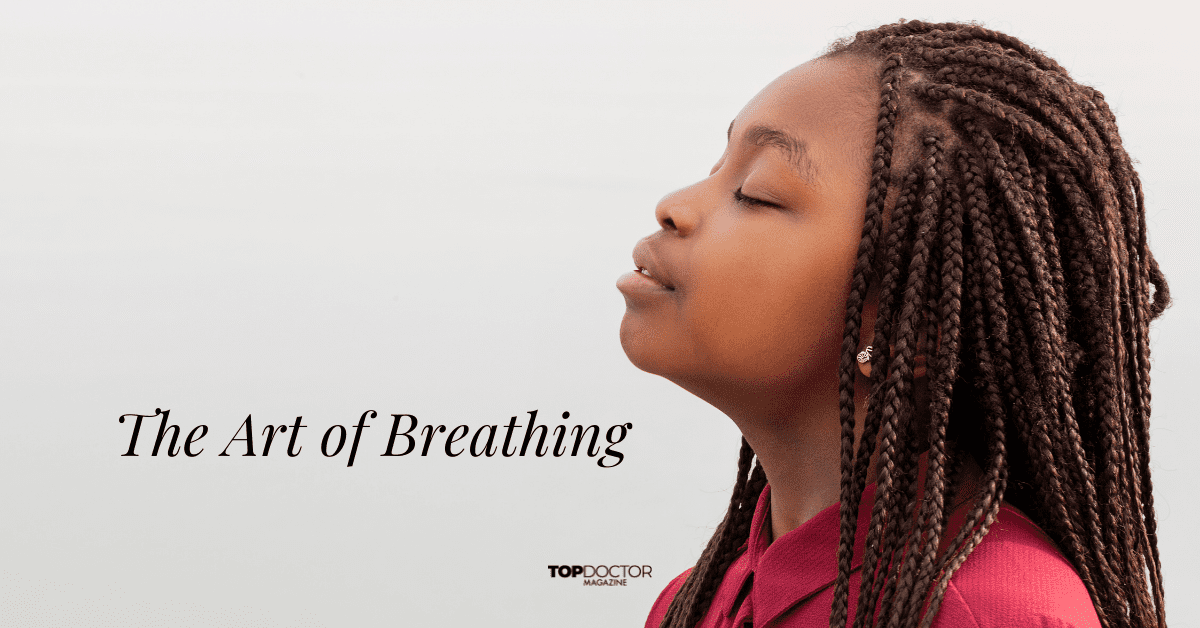When people talk about habitual actions, they often throw around phrases such as, it’s become second nature to me – almost like breathing. But, little do they know, just because breathing is habitual doesn’t mean they’re doing it correctly. Although the average human takes 22,000 breaths in one day, clinical psychologist and mental health and fitness expert Dr. Belisa Vranich estimates that 9.5 out of 10 people do it incorrectly.
From birth through roughly age five, children are horizontal breathers – pulling air through their nose and into their lungs and engaging their diaphragm, which causes their belly to expand as they inhale and collapse when they exhale. At some point after this, whether because of stress or the social pressures of having a flat stomach, nearly everyone switches to vertical breathing. This type of breathing disregards the diaphragm, relying on shallow breaths from the chest instead.
Are you wondering if you’re a part of the 5% that breathes correctly? Place one hand on your chest, the other on your stomach. Inhale in for six seconds, and exhale for six, taking note of how each hand moves. If your shoulders and the hand on your chest rise toward your chin with the inhale and the hand on your stomach caves in a bit, falling back toward your spine, there’s bad news: you’re a vertical breather.
Why Does Proper Breathing Matter?
Maybe you do breathe vertically. So do 95% of other people! You might think, big deal! Well, it turns out, it actually is. Poor breathing habits have been linked to high blood pressure, back pain and increased stress levels. Conversely, the positive mental and physiological effects of proper breathing are well established, forming the basis for practices such as Pranayama yoga and leading physicians to create entire exercises designed to correctly regulate breathing.
The harmful effects of unnatural breathing patterns are especially apparent in people with acute breathing difficulties. The fear arising from any inability to breathe correctly often triggers a panic attack, increasing the rate and irregularity of breathing, which in turn causes more fear. This harmful cycle can have disastrous effects on mental health. Studies indicate that some 60% of people with chronic obstructive pulmonary disease suffer from anxiety or depression.
The negative consequences arising from poor breathing are not only detectable on a psychological level but also on a biological level. Scientists have discovered a direct connection between breathing and the nervous system. In one study, scientists discovered that mice stayed calm in high-pressure situations so long as certain neurons were silenced, maintaining normal breathing patterns and thus failing to trigger a panic response in the brain.
Slow and rhythmic breathing stimulates the vagus nerve, a part of humans’ parasympathetic nervous system. The vagus nerve’s activity directly influences specific internal organs. When active, the heart rate slows, blood pressure drops and tightened muscles loosen. Even the brain relaxes, causing the entire body to feel calm and tranquil.

How Do I Regulate My Breathing?
After exploring the centrality of breathing to the body’s overall well-being and the severe consequences that can follow from unhealthy breathing patterns, the question naturally arises: what are some techniques to regulate breathing and mitigate these adverse effects?
Remember to practice correct horizontal breathing during all of the following exercises: deep breaths through the nose, engage the diaphragm and expand your tummy!
Cardiac Coherence: 365 Breathing
An apple a day might not keep the doctor away, but some therapists suggest that daily practice of this breathing exercise can significantly decrease stress and anxiety. 365 regulates breathing through six cycles per minute, for five minutes, three times a day. Each cycle consists of a 10-second breath pattern: inhale for five seconds, exhale for five seconds. Continue this pattern for five minutes, then go about your day! For maximum results, therapists recommend completing the five-minute loop three times in one day.
478 Breathing
The 478 technique is similar to the 365 pattern but instead requires an exhale twice as long as the inhale. This is because the heart rate slows during exhalation and speeds up slightly during inhalation. To complete the 478 exercise, inhale for four seconds, hold your breath for seven and exhale for eight. Repeat this cycle between four to eight times.
Pranayama Techniques
Pranayama is a type of breath regulation yoga that utilizes alternate nostril breathing, victorious breath, female honeybee humming breath and bellows breath to increase control over breath speed and regularity. Alternate nostril breathing improves cardiovascular and lung function, lowers heart rate and increases endurance.
Start with a complete exhale. Then, push down on your right nostril with your finger. Inhale through the left side and then push down on your left nostril as you simultaneously release your right. Next, exhale through your right nostril. Breathe in through your right nostril, close it, open the left and exhale. This cycle can be repeated for up to five minutes, always ending with an exhale out of the left nostril.
When Do I Practice Breathing Exercises?
These techniques (and a myriad of others) can be practiced at any time – when you feel stress levels rise, before bed to decrease heart rate and prepare for sleep, before presentations to decrease stage-fright or even as a part of your morning routine.
So now that you’ve learned how to breathe correctly, why regulated breathing is central to your overall health and are equipped with three types of breathing exercises, you’re well on your way to modulated breathing, decreasing stress and improving your overall health!






0 Comments